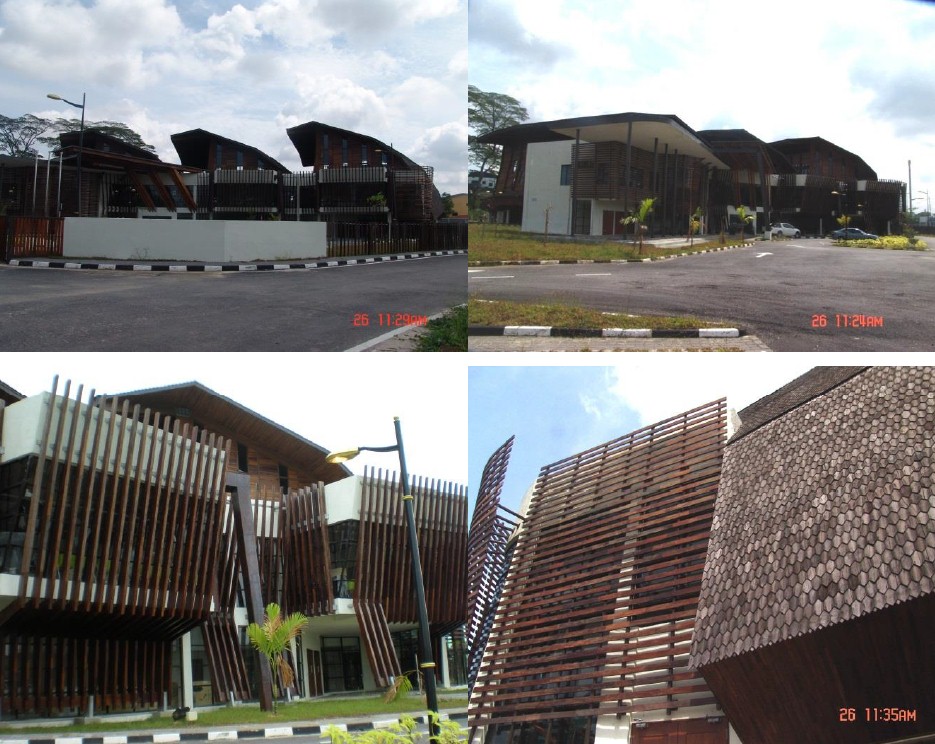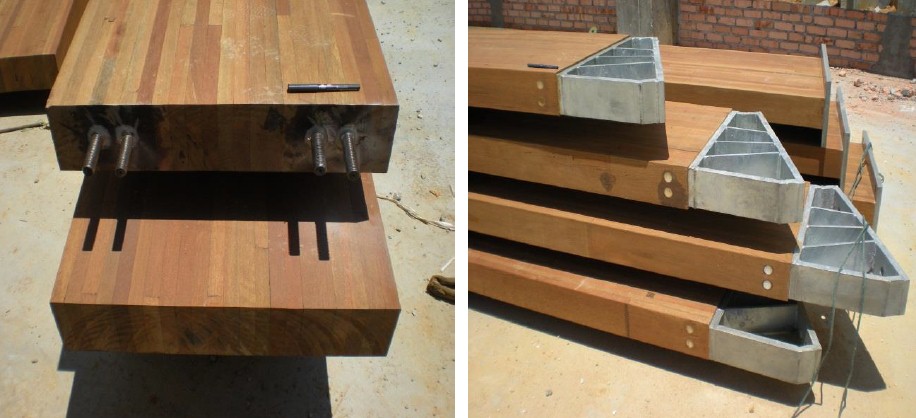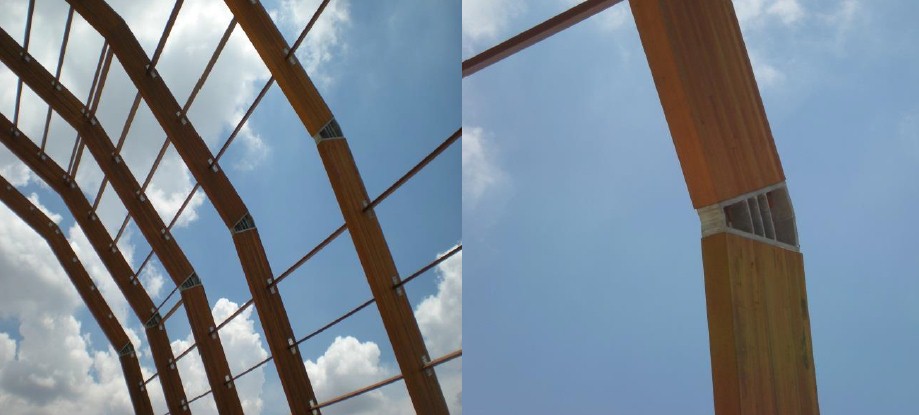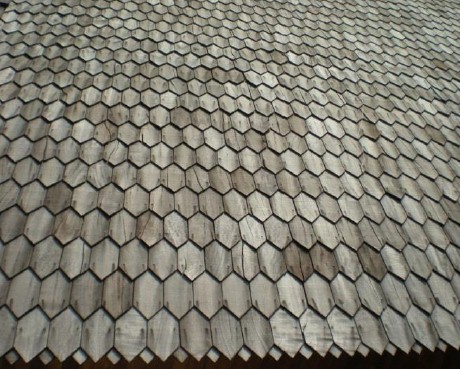
Bonded-In Joint In Existing Structure: The Malaysian Glulam Project
Strong and stiff joints of bond-in rods with excellent performance in load transfer have been used for glued-laminated timber. Steel rods, glass fibre-reinforced plastic (GFRP), and the potential use of carbon fibre-reinforced plastic (CFRP) reinforcing bars have been used to confer superior properties as reinforcement materials (Harvey & Ansell, 2000). Moreover, bonded in-rod is also less in weight, less grain-end splitting tendency, and has greater fire resistance ability (Broughton & Hutchinson, 2001).
The Malaysian Timber Industrial Board (MTIB) exhibition hall is the Malaysian first glue-laminated timber structure constructed using bonded-in connections (Figure 1). The exhibition hall and administration centre covering 4686m2 of floor area is situated on a 1.96 hectares site in the capital state of Johor.
The Malaysian Timber Industrial Board (MTIB) exhibition hall is the Malaysian first glue-laminated timber structure constructed using bonded-in connections (Figure 1). The exhibition hall and administration centre covering 4686m2 of floor area is situated on a 1.96 hectares site in the capital state of Johor.

Figure 1. Malaysian Timber Industrial Board (MTIB) exhibition hall in Johor
The building was designed of 3 arch-shaped halls, which are mainly of Malaysian hardwood glulam. The architectural design of the building preserved the dominance of wood as a building material. Two Malaysian indigenous wood species, Keruing (Dipterocarpus spp.) and Resak (Vatica spp.) were selected as glulam material for this project. The selection was made based on the natural durability and superior mechanical properties of the wood. The glulam material was manufactured in Johor and supplied by Woodsfield glulam.
Each glue-laminated section 130mm x 600 mm has a total span of 3 to 7 meters. The section elements were bonded using a steel rod to form arches. An epoxy-based room temperature curing structural adhesive supplied by Rotafix Ltd. was used to bond the metal rod to the timber. Bonding of galvanised steel rods to pre-drilled glulam was made at Woodsfield (Figure 2). A total of 39 glue-laminated arches were required to erect the exhibition hall. Overall, the structure required 351 moment-resisting adhesive bonded joints to link the arches. Some of the adhesive-bonded connections in detail are shown in Figure 3. The arches were crane lifted and bolted to the elevated concrete runners. The glue-laminated arches were then covered by water boil proof (WBP) plywood and thick rolled zinc sheet as a protective function. Belian wood (Eusideroxylon zwageri) shingles of 0.35mm x 100mm x 450mm dimension were installed as arch covering to maintain the aesthetic look of the exhibition hall (Figure 4). Balau (Shorea spp.) and Keranji (Dialium spp.) tongue and groove panels were installed between the internal section of the rib walls and roof of the hall (Figure 5).
Each glue-laminated section 130mm x 600 mm has a total span of 3 to 7 meters. The section elements were bonded using a steel rod to form arches. An epoxy-based room temperature curing structural adhesive supplied by Rotafix Ltd. was used to bond the metal rod to the timber. Bonding of galvanised steel rods to pre-drilled glulam was made at Woodsfield (Figure 2). A total of 39 glue-laminated arches were required to erect the exhibition hall. Overall, the structure required 351 moment-resisting adhesive bonded joints to link the arches. Some of the adhesive-bonded connections in detail are shown in Figure 3. The arches were crane lifted and bolted to the elevated concrete runners. The glue-laminated arches were then covered by water boil proof (WBP) plywood and thick rolled zinc sheet as a protective function. Belian wood (Eusideroxylon zwageri) shingles of 0.35mm x 100mm x 450mm dimension were installed as arch covering to maintain the aesthetic look of the exhibition hall (Figure 4). Balau (Shorea spp.) and Keranji (Dialium spp.) tongue and groove panels were installed between the internal section of the rib walls and roof of the hall (Figure 5).

Figure 2. Bonding of galvanised steel to glulam using Rotafix epoxy adhesive

Figure 3. Close up of bonded-in connection

Figure 4. Berlian shingles

Figure 5. Balau and Keranji panels
Since this is the first Malaysian glulam project completed using the bonded-in connection, few issues of concern should be addressed:
(a) Types of adhesive used in bonded-in joint.
The galvanised steel rods were bonded into pre-drilled glulam using a room temperature curing epoxy adhesive. According to LICONS guidelines, the modulus of the epoxy should be more than 1GPa and shear and tensile strength of more than 12MPa at 20oC. The Tg value of the epoxy should also be higher than 50oC (Broughton & Hutchinson, 2003). As known, an epoxy that cures at ambient temperature is not a fully cured adhesive. This posed questions on the mechanical properties of an un-fully cross-linked adhesive and the possibility of post-curing due to hot Malaysian weather.
(b) Types of wood material.
This project employs tropical hardwood species as glulam material. It is known that hardwood may have higher extractive content than softwood. Wood extractives may include a complex mixture of chemicals such as tannins, anthocyanins, flavones, and lignin. Keruing timber contains oleo-resin, which in some species is exuded on the end grain. The presence of extractive may interrupt the bonding mechanism of adhesive, which makes hardwood more difficult to glue. This gives a solid background to assess the bond strength of Malaysian hardwood species.
(c) Temperature and humidity.
Malaysia observes tropical weather with a temperature range of 23°C to 33°C (average 27°C). Annual precipitation in Malaysia is 2500mm, and relative humidity (RH) may range from 58% to 97%. As stated by the Eurocodes 5 (ENV 1995:1997), the usage of epoxy bond-in rod is only limited to service classes 1 and 2. All bonded-in connections are within the building's enclosure, which places this application under service class 2. It is important to consider the effect of service temperature on the durability of the adhesive. Close monitoring of temperature and displacement on the MTIB glulam structure was conducted by Smedley et al. (2012). On realizing the limitation on the information on the performance of joints under constant loading at high temperature and humidity, a study of the response of creep in bulk epoxy in relation to temperature increase was reported by Roseley et al. (2011) and Roseley et al. (2012).
Bonded-in technology for connections in timber structures relies on the effective bonding of steel or reinforced plastic rods to timber using room temperature cure epoxy adhesives. Extensive research is the solution to the present lack of information on the effective and safe application of bonded-in technology. Key issues include deformation and durability under creep loads at elevated temperatures and high relative humidity.
(a) Types of adhesive used in bonded-in joint.
The galvanised steel rods were bonded into pre-drilled glulam using a room temperature curing epoxy adhesive. According to LICONS guidelines, the modulus of the epoxy should be more than 1GPa and shear and tensile strength of more than 12MPa at 20oC. The Tg value of the epoxy should also be higher than 50oC (Broughton & Hutchinson, 2003). As known, an epoxy that cures at ambient temperature is not a fully cured adhesive. This posed questions on the mechanical properties of an un-fully cross-linked adhesive and the possibility of post-curing due to hot Malaysian weather.
(b) Types of wood material.
This project employs tropical hardwood species as glulam material. It is known that hardwood may have higher extractive content than softwood. Wood extractives may include a complex mixture of chemicals such as tannins, anthocyanins, flavones, and lignin. Keruing timber contains oleo-resin, which in some species is exuded on the end grain. The presence of extractive may interrupt the bonding mechanism of adhesive, which makes hardwood more difficult to glue. This gives a solid background to assess the bond strength of Malaysian hardwood species.
(c) Temperature and humidity.
Malaysia observes tropical weather with a temperature range of 23°C to 33°C (average 27°C). Annual precipitation in Malaysia is 2500mm, and relative humidity (RH) may range from 58% to 97%. As stated by the Eurocodes 5 (ENV 1995:1997), the usage of epoxy bond-in rod is only limited to service classes 1 and 2. All bonded-in connections are within the building's enclosure, which places this application under service class 2. It is important to consider the effect of service temperature on the durability of the adhesive. Close monitoring of temperature and displacement on the MTIB glulam structure was conducted by Smedley et al. (2012). On realizing the limitation on the information on the performance of joints under constant loading at high temperature and humidity, a study of the response of creep in bulk epoxy in relation to temperature increase was reported by Roseley et al. (2011) and Roseley et al. (2012).
Bonded-in technology for connections in timber structures relies on the effective bonding of steel or reinforced plastic rods to timber using room temperature cure epoxy adhesives. Extensive research is the solution to the present lack of information on the effective and safe application of bonded-in technology. Key issues include deformation and durability under creep loads at elevated temperatures and high relative humidity.
References
Broughton, J.G., and Hutchinson, A.R. (2001). Adhesive system for structural connections in timber. International Journal of Adhesive Adhesion, 21:177-186.
Broughton, J.G, and Hutchinson, A.R. (2003). “LICONS: Low Intrusion Conservation System for Timber Structures.”
Harvey, K., and Ansell, M.P. (2000). Improved Timber Connections Using Bonded-in GFRP Rods. In Proceeding of World Conference on Timber Engineering, Whistler, Canada.
Roseley, A., Ester Rojo, Martin P. Ansell, Dave Smedley. (2011). Creep response of thixotropic ambient temperature cure adhesives measured by DMTA in static tension and shear. International Journal of Adhesion and Adhesives, 31 (6), pp.575-582.
Roseley, A., Ansell, M.P., Smedley, D., and Porter, S. (2012). Creep of thixotropic adhesive in bonded-in timber connections as a function of temperature and humidity. World Conference on Timber Engineering 2012, Auckland, NZ
Smedley, D., Tiew, J., Roseley, A., Ahmad, Z., Ansell, M.P. (2012). Innovative timber exhibition hall in Johor Malaysia, constructed from indigenous hardwood using bonded-in moment resisting connections. World Conference in Timber Engineering, Auckland, NZ.
Broughton, J.G, and Hutchinson, A.R. (2003). “LICONS: Low Intrusion Conservation System for Timber Structures.”
Harvey, K., and Ansell, M.P. (2000). Improved Timber Connections Using Bonded-in GFRP Rods. In Proceeding of World Conference on Timber Engineering, Whistler, Canada.
Roseley, A., Ester Rojo, Martin P. Ansell, Dave Smedley. (2011). Creep response of thixotropic ambient temperature cure adhesives measured by DMTA in static tension and shear. International Journal of Adhesion and Adhesives, 31 (6), pp.575-582.
Roseley, A., Ansell, M.P., Smedley, D., and Porter, S. (2012). Creep of thixotropic adhesive in bonded-in timber connections as a function of temperature and humidity. World Conference on Timber Engineering 2012, Auckland, NZ
Smedley, D., Tiew, J., Roseley, A., Ahmad, Z., Ansell, M.P. (2012). Innovative timber exhibition hall in Johor Malaysia, constructed from indigenous hardwood using bonded-in moment resisting connections. World Conference in Timber Engineering, Auckland, NZ.
